#Family: Scarabaeidae
Text

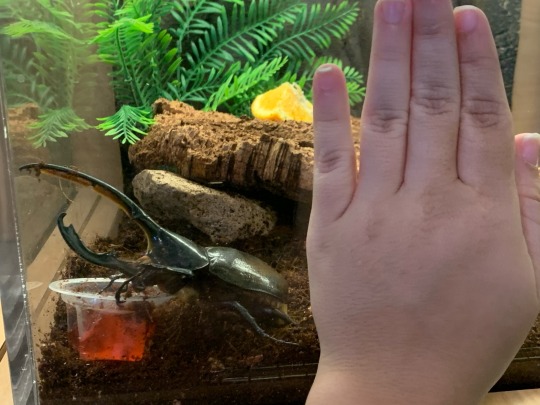
A beautiful Hercules beetle… with my hand as a size reference. So big!
#Phylum: Arthropoda#Class: Insecta#Order: Coleoptera#Family: Scarabaeidae#Genus: Dynastes#Dynastes hercules#hercules beetles#rhinoceros beetles#beetles#insects
2 notes
·
View notes
Text



Asian Goliath Beetle aka Reindeer Beetle (Dicronocephalus wallichii), male, family Scarabaeidae, Chiang Mai, Thailand
photograph by Pip Masion
#dicronocephalus#goliath beetle#scarab#scarabaeidae#beetle#coleoptera#insect#entomology#animals#nature#asia
2K notes
·
View notes
Text
Phoretic (living on the surface, but not parasites) organisms on sloths
A sloth moth is a coprophagous moth which has evolved to exclusively inhabit the fur of sloths and to use sloth dung as a substrate for the early stages of reproduction. Sloth moths include Bradypodicola hahneli,[1] Cryptoses choloepi,[1] Cryptoses waagei,[2] Cryptoses rufipictus,[2] and Bradypophila garbei.[2]
Certain lepidopteran moths of the snout moth family Pyralidae (namely subfamily Chrysauginae) have evolved to inhabit sloth fur exclusively. Typically, sloth moths follow a life-style broadly on the lines of Cryptoses choloepi, a moth in the snout moth family that lives exclusively in the fur of the brown three-toed sloth Bradypus variegatus infuscatus. Adult female moths leave the fur of the sloth to lay eggs in the sloth droppings when the sloth descends, once a week, to the forest floor to defecate. The larvae of Cryptoses choloepi live in the dung and newly emerged moths later fly from the dung pile into the forest canopy to find a host sloth.[3][4]
Chrysaugine moths, such as Cryptoses spp., spend their lives as adults in the fur of sloths, particularly the three-toed species, except when the sloths descend to defecate and females fly to the sloth dung to oviposit. An imbalance in population sex ratios favouring males has been noticed and surmised as female moths not making it back to host sloths after ovipositing.[1]Pale-throated sloth (Bradypus tridactylus)
Sloth moths are thought to get nutrients from the secretions of the sloths' skin and the algae present on the fur, as well as protection from avian predators.[1]
Some individual three-toed sloths have been recorded carrying more than 120 moths in their fur. Two-toed sloths are recorded as harbouring lower populations. Several different moth species may coexist on the same host animal.[1]
some people say that the moths eat the moss on the sloth but no. theres no moss on the sloth. there is algae on the sloth. and also mostly it seems they eat the sloth leavins of various kinds
on the algae:
Milla Suutari and colleagues found that the predominant algae inhabiting sloth fur was Trichophilus welckeri. It is passed directly from mother to offspring and young sloths gain the algae and other parasites by the time they are a few weeks old. This species of algae is host specific and has not been found to occur in any other environment. This finding adds strong support to the hypothesis that there is a co-evolutionary relationship between the sloths and the algae of the genus Trichophilus, which may well only exist as a symbiont.
special algae just for sloths.
but its not just sltohs and algae! there are beetles!
Beetles form a prominent portion of the arthropod community associated with sloth and sloth dung. A number of species of the coprophilous family Scarabaeidae are associated with three-toed but not two-toed sloths. The populations of these beetles can be quite large, in one case more than 980 beetles of the species Trichilium adisi were found in the fur of a single sloth. Beetles of the genus Uroxys have been recorded from sloths in Bolivia, Brazil, Colombia and Panama.[1]
Beetles appear to congregate preferentially in specific parts of the body. For example, scarab beetles occur near the elbow or on the flanks behind the knees buried deep inside the fur, while those of Trichilium spp have been found in the underfur of the lower back and thighs of Bradypus torquatus. Beetle larvae and some adult beetles use sloth dung for feeding. The population of beetles varies and the seasonal factors affecting the population size are yet to be ascertained.[1]
a little ecosystem just on the sloth... i wonder if other organisms filled this role before the sloth. arboreal dinosaur with bugs in its feathers!
29 notes
·
View notes
Text
Uncharismatic Fact of the Day
Scarab beetles are most commonly associated with ancient Egypt, but the species there represent only a tiny fraction of the population. Worldwide there are more than 32,000 described species of scarab beetle, including dung beetles, rose chafers, and rhinoceros beetles. Each year about 200 new species of scarab beetle are discovered.
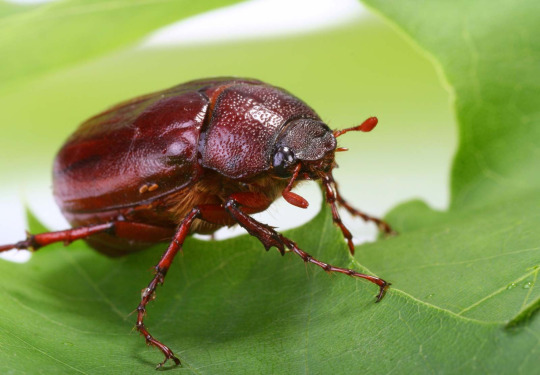
(Image: A June bug (Phyllophaga sp.), one of the members of the large Scarabaeidae family, by Piotr Kozikowski)
If you like what I do, consider leaving a tip or buying me a kofi!
163 notes
·
View notes
Text

Today’s anime insects of the day is: This assortment from Assassination Classroom
Order: Lepidoptera (butterfly) and Coleoptera (beetles) Lucanidae (middle beetle)
Family: Nymphalidae (butterfly) and Scarabaeidae (beetles)
#assassination classroom#beetle#butterfly#coleoptera#lepidoptera#nymphalidae#scarabaeidae#unfortunately i have covid :(#so posting wasnot my top priority#but on the bright side i get the whole week off work
162 notes
·
View notes
Note
no idea if you're tired of ID asks or asks from me but who is this fella? Colorado, on a tomato trellis
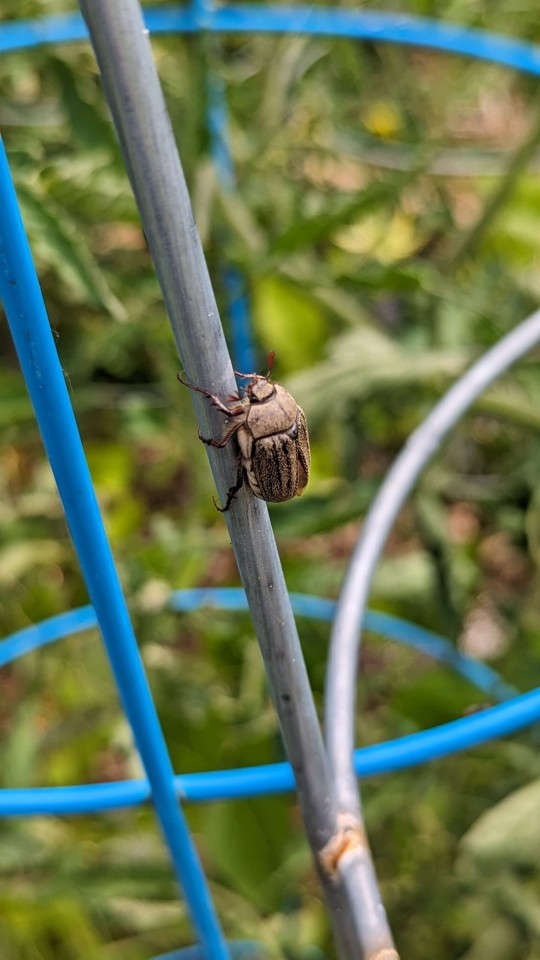
think it's one of these!
50 notes
·
View notes
Photo
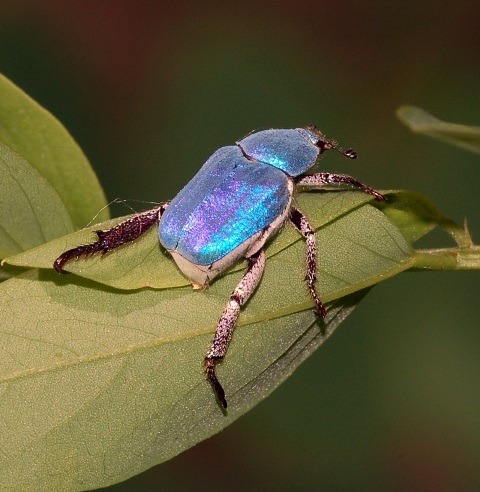
Hoplia caerulea, family Scarabaeidae, Bedarieux Orb, Languedoc-Roussillon, France
photograph by Fritz Geller-Grimm and Felix Grimm | Wikipedia CC
38 notes
·
View notes
Note
professor Gohan what the strongest bugs in the world also if you weren’t an entomologist what would you be?
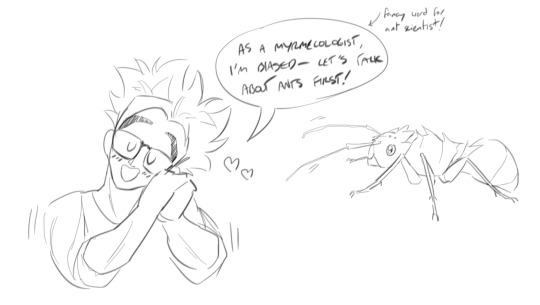
They're also the classic example of insect strength. I mean, what can't these little guys do?! They plow through the ground for their intricate tunnel systems, use their jaws to cut up everything from leaves to their enemies, and even build bridges and rafts by hanging from each others' bodies! The force of a trapjaw ant snapping its mandibles shut on a hard object can be enough to send itself flying several times its body length back, which looks silly but is a great escape route. And of course, they can lift tens of times their own body weight. To explain shortly, smaller animals have the potential to be very relatively strong because the surface area-volume ratio is more even at that scale. They weigh less and so have less to carry, so they can allocate strength to carrying larger objects than usual. A human-sized ant would be very strong, but not as proportionately strong as it was at its usual size. But let's move on from ants!
Apparently, the world's strongest insect and apparently overall strongest animal (once again relative to body mass!) is a dung beetle called Onthophagus taurus which has pulled more than 1,000 times its body weight in a study! This strength may have been sexually selected for due to males competing for females through competitions of brute strength. Beetles in the family Scarabaeidae are generally pretty strong, if you hold certain burrowing species in your hand you'll find that they can prise open your fingers quite easily!
The diabolical ironclad beetle (Phloeodes diabolicus) is another very strong beetle, but in a different way. Its exoskeleton, especially its elytra (the shell on its back), are incredibly durable and are constructed of layers that are meshed like puzzle pieces and cemented together by proteins that make them almost impossible to crush through natural means. The way the parts of the shell are interlaced also has given scientists a challenge to replicate their structure in human materials such as planes. Biomimicry is a crazy field! Also, you can imagine how notoriously difficult these things are to preserve for the... average entomologist.
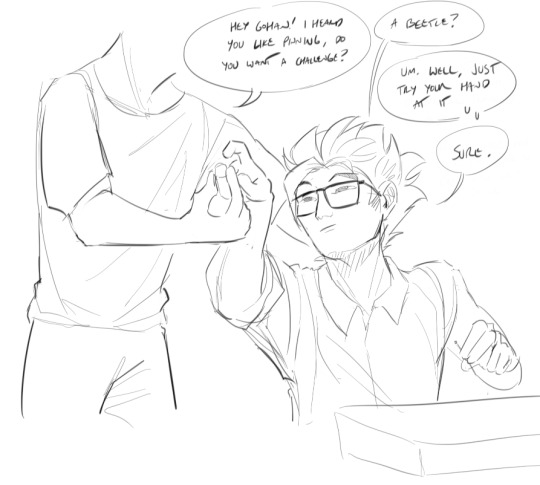


(It's true. Entomologists, in the name of science, have run over these beetles with their cars and they just shrugged it off.)
I don't want to make this post too long (you're strong yourself for getting this far!), but I should give honorable mentions to our saltatorial (jumping) friends in the order Orthoptera, which are your grasshoppers, crickets, and katydids. Even less well-known (or rather less-respected) are the fleas, which I personally find fascinating because their closest relatives are likely scorpionflies! Who knew such a tiny, flat insect with no wings but powerful hindlegs could have evolved from potentially such a dainty-looking ancestor.

As for an alternate career path... I'm very grateful to be studying the insects I love so much, but I've always been interested in all the sciences. One of my backup plans was to become a researcher or lab technician at Capsule Corporation, which would have dealt largely with mechanical engineering. I wonder how that would have gone!

#insects#entomology#dragon ball#dragon ball z#dragon ball super#dragon ball super super hero#dbz#dbs#dbssh#gohan#son gohan#mod jay
89 notes
·
View notes
Text
I was tagged by @sycamoretrees
9 people i’d like to get to know better
Last song: Recently I've been listening to The Birthday a lot while working. Kaminari Today gives me powerful Sasaki vibes. (A couple other faves are Kusottare no Sekai and Sayonara Saishu Heiki)
Favourite colour: That whole mint green, sea green, sage green, moss green family
Currently watching: Delicious In Dungeon and Bravern! The Delicious In Dungeon anime adaptation is outstanding and really captures the feeling of the manga. Bravern is a very fun and unique mecha series (created by the guy who designed NJPW's IWGP World Heavyweight Championship belt) - if you want to watch it, I highly recommend not reading anything about it beforehand because the surprise twists and turns are a big part of the fun. Bravern just recently ended, so the whole series is available to watch.
Spicy/savoury/sweet/(sour)/(salty): I'll go with salty aspirationally, because I'm supposed to increase the salt in my diet. But I do have a sweet tooth, I do love umami flavors, and I do have a growing appreciation for spicy foods.
Relationship status: Very happily partnered
Obsessions: I managed to turn my fixation on Japanese pro wrestling into a fixation on learning Japanese, which has been very fun even though I don't have any particular aptitude for language learning.
I'm also obsessed with beetles, especially species in the Scarabaeidae and Tenebrionidae families (scarabs including stag and rhino beetles, and darkling beetles). I currently have three pet beetles - two blue death-feigning beetles and one smooth death-feigning beetle. Someday I want to raise a stag or rhino beetle from a grub to an adult, but I haven't attempted it yet.
I also love wooden tall ships, especially square-riggers.
I'm tagging @thebarefootking @namajague @randanopterix @sangrebomb and @sharky-chan for this, but I'm supposed to tag four more people, so anyone else who sees this and would like to fill it out, please consider yourself tagged!
#get to know you question meme#thanks sycamoretrees for tagging me in this but sorry it took me forever to actually fill it out#I put these in my drafts and then completely forget about them lol...
4 notes
·
View notes
Text

Finally got to trying to ID these fellas. From left to right:
Eupompha elegans
A member of the Hydrophilus genus
Some member of the Blattodea order, Blattaria specifically (cockroaches only on this side of things)
Graphsoma italicum
A possible member of the Cosmopepla genus? I looked high and low for anything similar but found nothing lol
Protaetia brevitarsis
(Possibly) Chrysochus cobaltinus
Gryllus pennsylvanicus
A member of the Xylocopa subfamily (presumably, if casing in resin hadn't destroyed valuable hairs on the bee's body that'd help with ID)
A member of the Scarabaeidae family
And also a member of the infraorder Cimicomorpha (part of the Hemiptera family)
And finally, Chrysochus auratus
Now I'm no professional at this stuff BUT I did spend tons of time painstakingly checking everything. Obviously I may be wrong due to my inexperience with ID'ing bugs but at the same time I think I did decently well with the things I already knew + the resources I have on hand.
#not art#bugs#tw animal death#// animal death#NO BUT THAT BIG ASS BEETLE IS INSANE. HOW'D IT GET PUT IN THERE
4 notes
·
View notes
Note
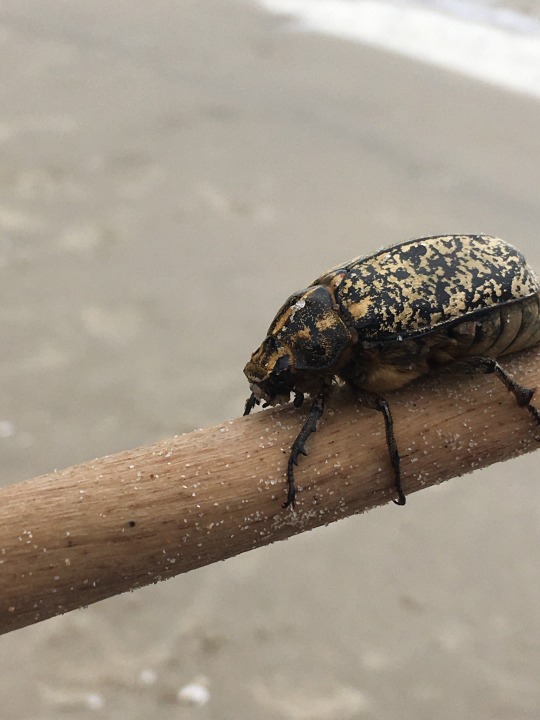
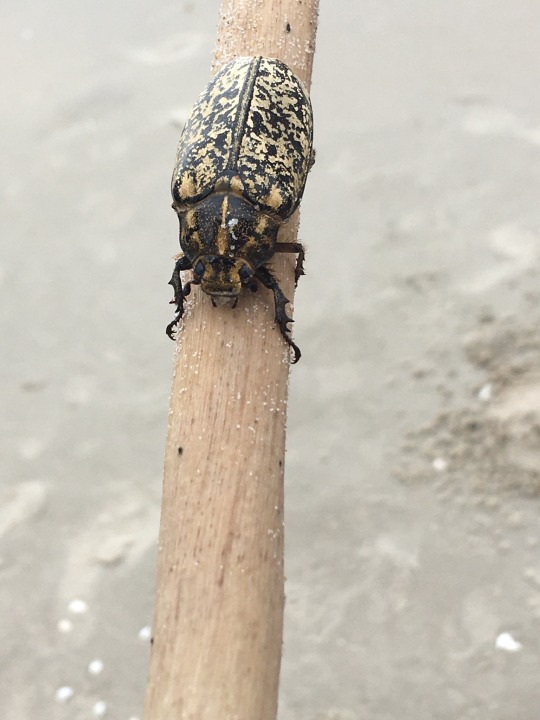
hi, may i request assistance in ID’ing this guy? it’s about 5cm in length, found on a baltic sea side. was holding on tight first onto some sea weed, then on my stick, and was screeching in a thin little voice at me when i gently moved him away from some gulls, he was quick to climb onto my stick to get away.
Looks like a scarab beetle, Scarabaeidae family, Polyphylla species. I am not familiar with your area so cannot say more than that!
57 notes
·
View notes
Text
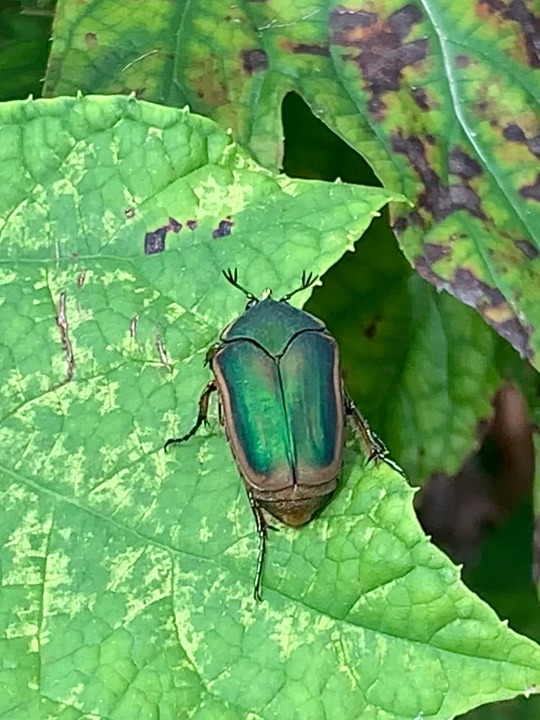

A pretty Green June Beetle!
#Phylum: Arthropoda#class: insecta#Order: Coleoptera#Family: Scarabaeidae#Genus: Cotinis#Cotinis nitida#Green June Beetles#June Beetles#beetles#insects
0 notes
Text
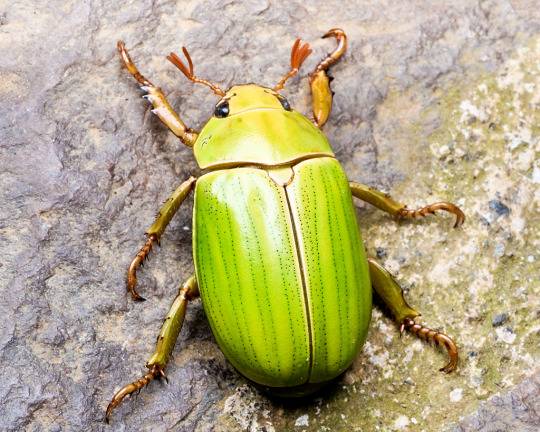
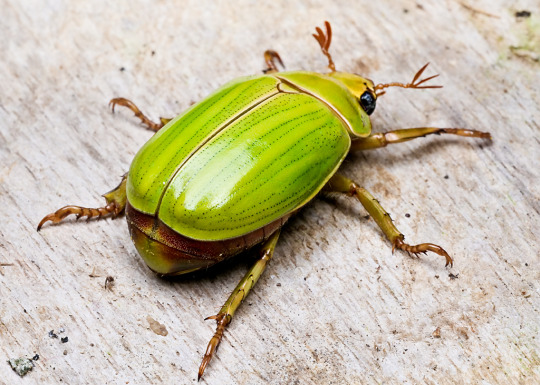
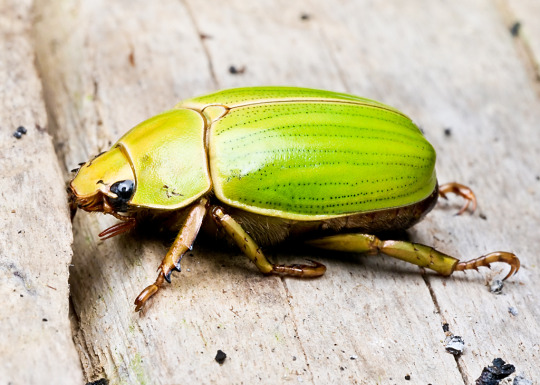
Green Scarab (Pelidnota prasina), family Scarabaeidae, Finca Heimatlos Eco Lodge and Farm, near Puyo, Ecuador
photograph by Eerika Schulz
2K notes
·
View notes
Text
Top 10 instances of each taxonomic rank by number of named species
Data from Catalogue of Life (yes, I'm aware that taxonomic rank is largely arbitrary and that species boundary are fuzzy, especially outside of Eukaryotes; taxa within "quotes" are paraphyletic groups whose descendance encompasses others, e.g. "Reptilia" also contains the ancestry of Aves)
Largest Domains:
Eukarya (organisms with cell nuclei): 2.1 million species
Bacteria: 10,000 [currently named!] species
Archaea: 380 species
Largest Kingdoms:
Animalia or Metazoa (animals): 1.5 million species
Archaeplastida (green plants & kin): 380,000 species
Fungi (fungi): 160,000 species
"Protista" (all Eukaryotes that are not animals, plants, or fungi; Catalogue of Life splits from them the old "Chromista", but now that's not supported by morphology nor by phylogeny): 65,000 species
Largest Phyla:
Arthropoda (insects, crustaceans, spiders, &c): 1.2 million species
Angiospermae (plants with flowers): 350,000 species
Mollusca (clams, snails, slugs, and squids): 130,000 species
Ascomycota (various groups of fungi): 98,000 species
Chordata (vertebrates, lancelets, and sea squirts): 73,000 species
Basidiomycota (another group of fungi including most mushrooms): 53,000 species
Foraminifera (protists with calcareous shells): 50,000 species [this might count a great deal of extinct species]
Platyhelminthes (tapeworms & other flatworms): 23,000 species
Bryozoa (little colonial invertebrates): 21,000 species
Annelida (earthworms, leeches, & other segmented worms): 18,000 species
Largest Classes:
Insecta (insects): 970,000 species
"Magnoliopsida" (most flower plants): 260,000 species
Gastropoda (slugs & snails): 97,000 species
Arachnida (spiders, scorpions, and mites): 93,000 species
Liliopsida (a group of flower plants including grasses): 81,000 species
Malacostraca (crabs, shrimps, and some other crustaceans): 46,000 species
Agaricomycetes (mushrooms including agarics): 41,000 species
Dothideomycetes (another group of fungi): 32,000 species
Actinopterygii (ray-finned fish): 31,000 species
Bivalvia (clams, scallops, oysters, &c): 22,000 species
[Mammalia (mammals): 6000 species]
Largest Orders:
Coleoptera (beetles): 330,000 species
Diptera (flies & mosquitoes): 170,000 species
Lepidoptera (moths & butterflies): 160,000 species
Hymenoptera (ants, wasps, & bees): 120,000 species
Hemiptera (aphids, cicadas, & bedbugs): 100,000 species
Araneae (spiders): 50,000 species
Asparagales (orchids, onions, & agaves): 41,000 species
Asterales (daisies, dandelions, & sunflowers): 39,000 species
Orthoptera (crickets and grasshoppers): 30,000 species
Lamiales (mint, olives, and many herbs): 28,000 species
[Primates (lemurs, monkeys, & apes): 530 species]
Largest Families:
Curculionidae (weevils): 74,000 species
Staphylinidae (rove beetles): 67,000 species
Carabidae (ground beetles): 41,000 species
Cerambycidae (longhorn beetles): 36,000 species
Scarabaeidae (scarab beetles): 36,000 species
Asteraceae (most Asterales): 36,000 species
Orchidaceae (orchids): 31,000 species
Ichneumonidae (parasitoid wasps): 24,000 species
Fabaceae (beans): 24,000 species
Erebidae (a family of moths): 23,000 species
[Hominidae (great apes including humans): 8 species]
2 notes
·
View notes
Note
Seen any cool bugs lately?
!!!!!!!! I love you bug anon
It's not that recent but I still think about this little sweetheart I saw a few months ago,
I was outside when I saw this little grub just crawling around. I didn't know what exactly it was at first, but I'm a weird bug person so of course I'm a member of a bug identification group on Facebook🤣with a photo and description (it was crawling on its back! How neat is that!) , turns out it was a larvae from the Scarabaeidae family!!! Sadly unable to tell the exact type but it was so cute and 🥹
Pic of bug/larvae below the cut! If you don't like worm looking bugs be warned!
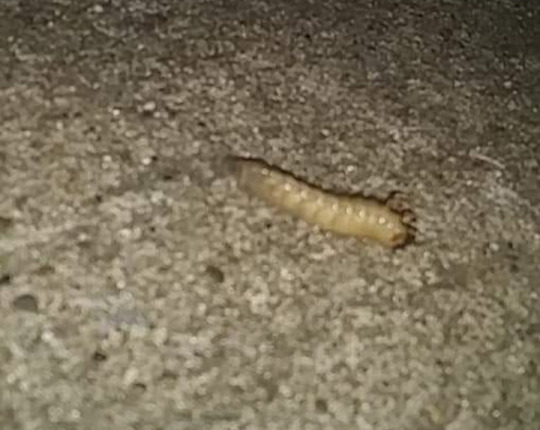

3 notes
·
View notes
Text
i’m sorry, European beetles of the genus Melolontha, in the family Scarabaeidae are commonly named WHAT
3 notes
·
View notes